Table of Contents
Introduction
Did you know that approximately 30% of people experience dry skin at some point in their lives? This statistic highlights just how common skin hydration concerns are. Yet, navigating the vast array of moisturisers available can feel overwhelming. With so many products boasting various benefits, how do we discern which one is right for us?
At Moon and Skin, we understand that skincare is a deeply personal journey that evolves over time, much like the phases of the moon. Our mission is to provide clean, thoughtful skincare solutions tailored for every phase of life. In this post, we’ll guide you through essential considerations for choosing the perfect moisturiser for your unique skin type and needs, including key ingredients and formulations to look for.
By the end of this article, we aim to empower you with the knowledge to make informed decisions about your skincare. Let’s delve into the world of moisturisers!
Understanding Your Skin Type
Before we explore what to look for in a moisturiser, it’s crucial to identify your skin type. Each type has its own unique characteristics and needs:
- Normal Skin: This skin type is generally well-balanced, not too oily or dry. People with normal skin can often use a variety of moisturisers, but lightweight options are typically best for daily use.
- Dry Skin: Characterized by flakiness, tightness, and sometimes itchiness, dry skin requires a rich, hydrating moisturiser. Look for thicker creams or ointments that can lock in moisture.
- Oily Skin: If your skin produces excess oil, you’ll want a lightweight, oil-free moisturiser that hydrates without clogging pores. Gel-based formulas often work well for this skin type.
- Combination Skin: This skin type can be dry in some areas (often the cheeks) and oily in others (usually the T-zone). A versatile moisturiser that can manage both dryness and oiliness is ideal.
- Sensitive Skin: If your skin tends to react to products, it’s vital to choose a moisturiser that is fragrance-free and formulated with gentle ingredients.
Understanding your skin type is the first step in selecting the right moisturiser. Once you have that figured out, you can explore the specific attributes to look for.
The Importance of Ingredients
When evaluating moisturisers, the ingredient list is your best friend. Here are some key components to consider:
1. Humectants
Humectants are ingredients that attract moisture from the environment into the skin. Common humectants include:
- Hyaluronic Acid: This powerhouse ingredient can hold up to 1,000 times its weight in water, making it a must-have for any moisturiser aimed at hydration. Our Hyaluronic Brightening Moisturizer harnesses the hydrating power of hyaluronic acid while also brightening the skin.
- Glycerin: Another highly effective humectant, glycerin helps draw moisture to the skin's surface, promoting a plump and hydrated appearance.
2. Emollients
Emollients work to soften and smooth the skin, making them essential in a moisturiser. They help improve the skin's texture and barrier function. Look for:
- Shea Butter: A natural option that offers deep hydration and nourishment.
- Dimethicone: This silicone-based emollient creates a protective barrier on the skin, helping to retain moisture without feeling heavy.
3. Occlusives
Occlusives form a protective barrier on the skin to prevent moisture loss. They are especially beneficial for individuals with dry skin. Common occlusives include:
- Petrolatum: A classic occlusive agent known for its moisture-locking properties.
- Beeswax: A natural occlusive that also provides soothing benefits.
4. Active Ingredients
Depending on your skin concerns, you might want to look for specific active ingredients:
- Vitamin C: Known for its brightening and antioxidant properties, vitamin C can help improve skin tone and texture. Our Stem Cell C Serum is a fantastic option to consider.
- Retinol: A powerful ingredient for anti-aging, retinol promotes cell turnover and can help reduce the appearance of fine lines and wrinkles. Our Liposomal Retinol Serum is designed for minimal irritation while delivering maximum results.
What to Avoid
While knowing what to look for is essential, it’s equally important to be aware of what to avoid in moisturisers:
- Fragrances: These can irritate sensitive skin. Opt for fragrance-free products whenever possible.
- Alcohol: Some alcohols can be drying to the skin. Look for moisturisers that are free of drying alcohols like ethanol.
- Parabens and Phthalates: These preservatives can cause adverse reactions in some individuals. Many clean beauty brands, including Moon and Skin, formulate without these ingredients.
Application Techniques for Maximum Benefit
Once you’ve selected your ideal moisturiser, how you apply it can significantly affect its efficacy. Here are some tips:
- Apply on Damp Skin: For optimal absorption, apply your moisturiser while your skin is still damp. This helps to lock in moisture.
- Layering: If you use serums or oils, apply your moisturiser last in your routine to seal in all the beneficial ingredients.
- Gentle Massage: Use gentle, upward strokes when applying your moisturiser to stimulate circulation and promote absorption.
Building a Complete Skincare Routine
While finding the right moisturiser is vital, it’s only one part of a complete skincare regimen. Here’s how to build a balanced routine:
- Cleansing: Start with a gentle cleanser, like our Superfood Cleanser, to remove impurities without stripping the skin of its natural oils.
- Toning: If you use a toner, opt for one that hydrates and prepares your skin for the next steps.
- Serums: Incorporate serums that target your specific skin concerns, such as brightening or anti-aging.
- Moisturising: After applying serums, use your chosen moisturiser to lock in hydration.
- Sun Protection: In the morning, always finish with a broad-spectrum sunscreen to protect your skin from UV damage.
For a complete skincare routine, consider our Bundle & Save options, which allow you to experience our core products at a better value.
Conclusion
Choosing the right moisturiser is an essential step in nurturing your skin and addressing specific concerns. By understanding your skin type, recognizing beneficial ingredients, and applying your products correctly, you can enhance your skin’s health and radiance. At Moon and Skin, we’re committed to supporting your skincare journey with clean, thoughtful formulations designed for every phase of life.
Ready to elevate your skincare routine? Explore our Best Sellers collection or try our products risk-free with our Try Before You Buy offer!
FAQ
Q: How often should I apply moisturiser?
A: It's best to apply moisturiser twice daily—once in the morning and once at night.
Q: Can I use the same moisturiser for my face and body?
A: While some products are safe for both areas, it's generally recommended to use formulations designed specifically for the face, as they tend to be lighter and non-comedogenic.
Q: What’s the difference between a cream and a lotion?
A: Creams are thicker and often more hydrating due to a higher oil content, while lotions are lighter and water-based, making them suitable for oily skin types.
Q: Should I change my moisturiser with the seasons?
A: Yes, your skin's needs can change with the seasons. In colder months, consider a thicker, more hydrating formula, while in warmer months, a lighter lotion may suffice.
Q: Are all natural moisturisers safe for sensitive skin?
A: Not necessarily. Even natural ingredients can cause reactions in sensitive skin. Always check for allergens and perform a patch test with new products.
In our commitment to clean, thoughtful skincare, we hope this guide serves as a valuable resource in your journey toward healthy, radiant skin.







